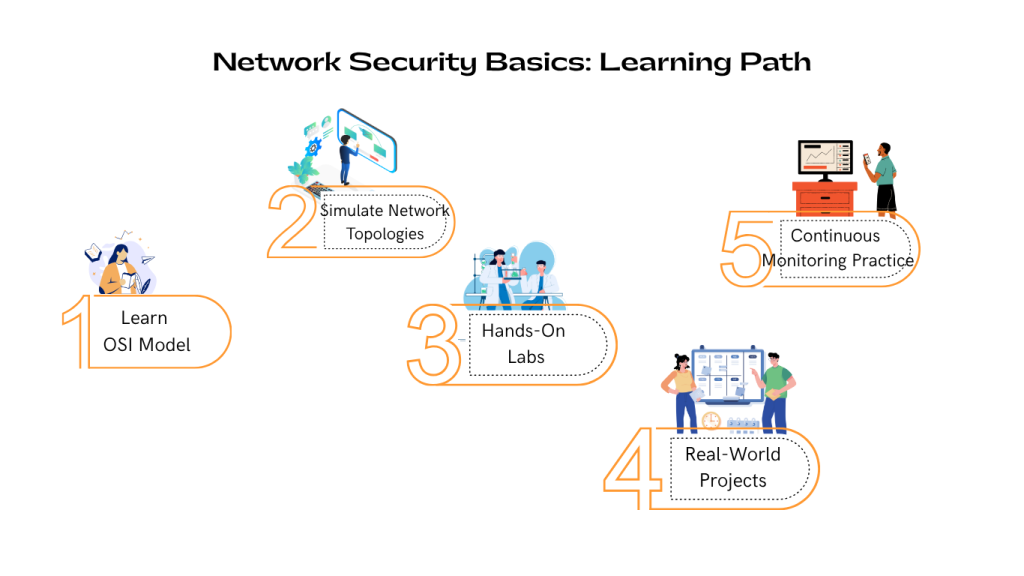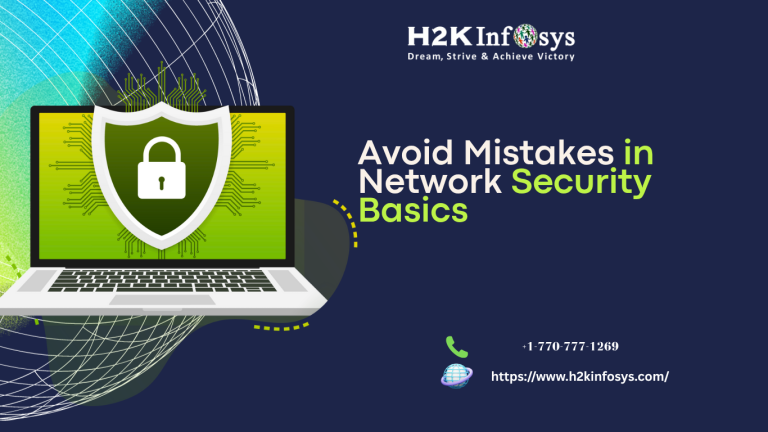Introduction: Why Getting the Basics Right in Network Security Matters
In today’s interconnected world, mastering Network Security Basics is non-negotiable. Whether you’re pursuing Cyber security training and placement or entering the job market, a weak grasp of foundational security principles can leave systems exposed. The importance of securing digital assets begins with a deep understanding of how networks work and where vulnerabilities lie.
This blog post walks you through the most common mistakes professionals make in Network Security Basics and how to avoid them. If you’re currently enrolled in a Cyber security course with placement or considering cyber security analyst training online, this guide is a must-read to strengthen your core concepts.
Why Network Security Basics Are Critical in 2025 and Beyond
Understanding Network Security Basics is the first step in protecting sensitive data from unauthorized access. Network breaches don’t happen solely due to complex exploits many are the result of simple oversights like weak passwords, poor segmentation, and unpatched systems.
Professionals in Cybersecurity training and job placement programs are often surprised to learn that even large organizations have suffered attacks due to missing the fundamentals. Whether you’re managing routers, firewalls, or endpoints, a strong command of Network Security Basics helps you create a secure, layered defense.
Top 10 Mistakes in Network Security Basics and How to Avoid Them
1. Weak or Default Passwords
Mistake: Using default login credentials like “admin” or weak passwords.
Why It’s Dangerous: Brute-force and dictionary attacks can crack them in seconds.
Network Security Basics Tip: Always enforce strong password policies and educate users through cyber security training courses.
Improper Network Segmentation
Mistake: Treating all devices the same, without boundaries.
Why It’s Dangerous: Malware can spread easily across the flat network.
Network Security Basics Tip: Implement VLANs and internal firewalls to limit access between segments.
Skipping Regular Patches and Updates
Mistake: Failing to update firmware and software on network devices.
Why It’s Dangerous: Exploits for known vulnerabilities exist in the wild.
Network Security Basics Tip: Create a patch management schedule and follow it diligently.
Firewall Misconfiguration
Mistake: Opening unnecessary ports or using “allow all” rules.
Why It’s Dangerous: Creates unrestricted access to your systems.
Network Security Basics Tip: Apply the principle of least privilege. Practice firewall configurations in cyber security analyst training online.
Lack of Traffic Monitoring
Mistake: Assuming the network is secure without visibility.
Why It’s Dangerous: Intrusions go undetected for weeks or months.
Network Security Basics Tip: Use IDS/IPS and log analysis to detect anomalies.
Endpoint Neglect
Mistake: Overlooking the security of endpoints like laptops and mobile devices.
Why It’s Dangerous: These are often the entry point for attacks.
Network Security Basics Tip: Install endpoint protection tools and manage them centrally.
Disabling Essential Security Features
Mistake: Disabling firewalls or antivirus for convenience.
Why It’s Dangerous: It breaks the basic defense layers.
Network Security Basics Tip: Never disable critical protections; instead, configure them appropriately.
Untrained Users
Mistake: Users are unaware of phishing, social engineering, or unsafe browsing.
Why It’s Dangerous: Most breaches occur due to human error.
Network Security Basics Tip: Include end-user awareness modules in every cyber security training near me program.
Lack of Configuration Backups
Mistake: Not saving device configurations.
Why It’s Dangerous: Delays recovery during outages or attacks.
Network Security Basics Tip: Backup configs periodically and store them securely.
Believing One-Time Setup is Enough
Mistake: Setting up network defenses and ignoring ongoing monitoring.
Why It’s Dangerous: Attack strategies evolve continuously.
Network Security Basics Tip: Perform regular audits, vulnerability scans, and training refreshers.

Mastering Network Security Basics: Practical Learning Path
If you’re enrolled in a Cyber security course and job placement or exploring online classes cyber security, here’s a practical roadmap to mastering Network Security Basics:
Step 1: Learn the OSI Model
- Understand each layer and common attack vectors.
Step 2: Simulate Network Topologies
- Practice network segmentation using tools like Cisco Packet Tracer or GNS3.
Step 3: Hands-On Labs
- Configure firewalls, VPNs, and access control lists as part of your Cyber security training courses.
Step 4: Real-World Projects
- Create security policies, perform penetration tests, and simulate data breaches.
Step 5: Continuous Monitoring Practice
- Analyze traffic logs, implement intrusion detection systems, and document network activity.
These foundational steps reinforce Network Security Basics in real-life scenarios that every aspiring security analyst must face.
Real-World Scenario: What Happens When You Ignore Network Security Basics?
A 2024 breach at a mid-sized healthcare provider occurred due to a misconfigured firewall and the use of an outdated router firmware. The attackers gained access through an unpatched VPN tunnel and extracted patient data undetected for over six weeks.
This incident became a widely discussed case study in Cybersecurity training and placement programs. The core failure? A misunderstanding of Network Security Basics, especially around patch management, segmentation, and monitoring.

Tools That Help Reinforce Network Security Basics
- Wireshark: For traffic analysis
- Snort: Network intrusion detection
- Nmap: Port scanning and network mapping
- GNS3 / Packet Tracer: For virtual network labs
- Firewall appliances: Hands-on with pfSense or Cisco ASA
These tools are often included in cyber security analyst training online and help you develop practical confidence in applying Network Security Basics.
Who Should Learn Network Security Basics?
If you belong to any of the categories below, understanding Network Security Basics is essential:
- IT Graduates joining Cyber security training and placement
- Career Switchers entering cybersecurity through cyber security training courses
- Working Professionals upskilling via online classes cyber security
- Job Seekers preparing for SOC or network security analyst roles
- Students looking for Cyber security course with placement options
Why Choose H2K Infosys for Cyber Security Training?
At H2K Infosys, our cybersecurity programs go beyond theory:
- You will master Security Basics through live projects and case studies.
- Our instructors guide you with real-time examples.
- We prepare you for interviews and certification exams.
- Our Cyber security training and placement support help you transition into job roles with confidence.
- Flexible schedules and virtual labs make cyber security analyst training online accessible and practical.
Conclusion: Master the Basics, Build a Bulletproof Career
Avoiding mistakes in the Basics is the first step toward building a strong cybersecurity foundation. These concepts will carry you throughout your journey, from beginner-level training to advanced roles in the industry.
Join H2K Infosys today to learn the Basics the right way through hands-on training, real-world scenarios, and job-ready preparation!


























